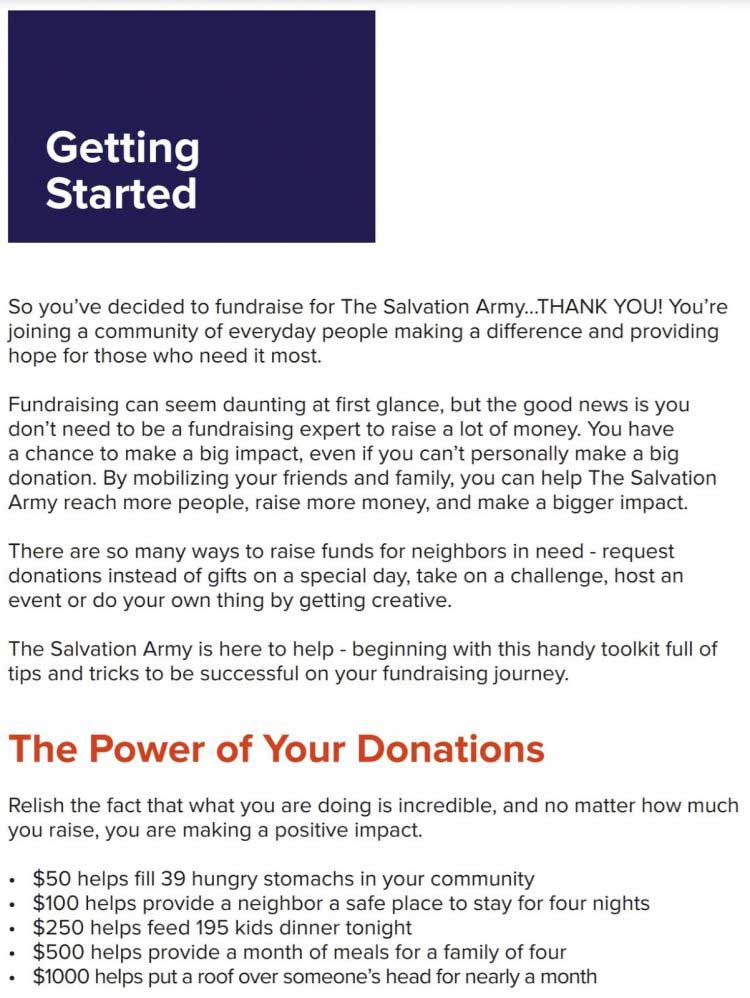What You Need in Your Nonprofit’s Fundraiser Toolkit

With Classy’s peer-to-peer and registration with fundraising campaign types, your supporters can sign up to fundraise on your behalf. This can be a great way to expand your reach. However, many of the participants in these campaigns often are not professional fundraisers, so they need a little help along the way to ensure they can be as successful as they want to be.
To assist with participants’ success, nonprofits can create fundraiser toolkits that provide guidance both technically for the peer-to-peer fundraising sign-up process and strategically for outreach to potential donors.
In this post, we’ll cover eight key items to include in your fundraiser toolkit that can equip and empower your supporters while simplifying the process.
Your Peer-to-Peer Fundraising Toolkit Template
1. Thank You and Welcome Messages
Begin your fundraiser toolkit with a quick thank-you note to the supporter for participating. Showing your appreciation upfront helps to strengthen the fundraiser’s connection with your nonprofit.
Within this introduction, you can also include some basic background information on your history, mission, and values. Additionally, if your fundraiser toolkit is for a specific challenge, such as an annual walk, you can share a little more about the event, including how and why it got started and its overall timeline.
The Salvation Army begins its fundraiser toolkit with a one-pager that highlights its mission. On the next page, titled “Getting Started,” the nonprofit starts with a big “THANK YOU!” and then moves into reassuring the fundraiser that they can be successful with their goal. They do so while also highlighting some figures on what different donation amounts allow the nonprofit to do, such as “$50 helps fill 39 hungry stomachs in your community.”
By saying thank you and expressing support for the fundraiser’s goal upfront, The Salvation Army sets the tone for the rest of the toolkit.

2. Step-By-Step Instructions to Set Up a Fundraising Page
After your welcome message, you’ll want to cover the nitty gritty details of how a fundraiser can actually set up and personalize their fundraising page. Explain the process step by step and have someone who has never done it before test your instructions to make sure they’re easy to follow.
In your instructions, you can also include helpful tips for things like what campaign photo the fundraiser might want to use, or ideas for their campaign page’s headline. Adding screenshots of the registration page and links to additional resources further clarifies your instructions.
The example below from Hope for Haiti’s 2020 fundraiser toolkit shows how you can incorporate screenshots to make registration steps clear.

3. High-Level Tips for Success
After a welcome message and instructions on how to create a fundraising page, the remainder of your fundraiser toolkit will provide tips for how fundraisers can use storytelling, social media, and other stewardship strategies to be successful with their campaigns. However, before diving into the details, it’s helpful to set the stage with a quick summary of high-level tips for success.
Choose 2 to 4 messages you want to call out specifically for fundraisers to consider during their efforts. These could include tips, such as:
- A reminder to make the campaign personal by including photos and stories that demonstrate how the fundraiser is getting involved and why this cause matters to them
- Thoughts on setting a specific fundraising goal to help the fundraiser’s community rally around an attainable target
- Encouragement for the fundraiser to be their first donor to show others their commitment to the cause
The example below from Hope for Haiti shows how to highlight these tips in a digestible way.

4. Storytelling Examples
Storytelling is a key way to connect donors to your campaign and humanize the fundraising process. Rather than simply asking for money, storytelling allows fundraisers to ask for donations that support a meaningful cause.
Download the Guide to Nonprofit Storytelling
A great way to help fundraisers see how they can tell the story of their campaign is to link to past storytelling examples from other successful campaigns. The Salvation Army includes links to three different examples in its toolkit, including:
- A personal story from a 99-year-old WWII Army Veteran on what food means to him, having lived through the Great Depression, and how his walking fundraiser will support the nonprofit’s food shelf
- How one middle school’s COVID-19 relief campaign started a socially distanced fitness challenge to show how people can help out together even while having to be apart
- One supporter’s quest to motorcycle through 48 states in 10 days to fundraise for everyone The Salvation Army serves every day
These different examples demonstrate to fundraisers the many unique ways they can tell their stories on their campaign pages. Including examples in your toolkit can assist fundraisers struggling to move from a blank campaign page to a meaningful landing point for supporters.
Social media is a key way many fundraisers will share their efforts with their communities. Include sample text in your fundraiser toolkit that can be easily personalized or copied and pasted directly into Twitter, Facebook, Instagram, and other social media platforms.
Hope for Haiti includes a page in its toolkit for each social media type, such as the one for Twitter posts below.

Since posts with images often create higher engagement on social media, it can also be helpful to include a link to a shared folder that fundraisers can access for images to attach to their social media posts.

You’ll also want to list any specific hashtags, shortened URLs, or social media handles for your nonprofit or event that you want your fundraisers to tag in their posts. By using these, you’ll be able to easily find and re-share or otherwise engage with your supporters’ posts to encourage their continued participation.

6. Outreach Tips
There are many ways you can support your fundraisers in their outreach efforts. The first is to include a suggested timeline for when to conduct what outreach, including social media posts, emails, or phone calls.
The example below from Hope for Haiti shows the overall timeline for its event-based campaign and what the overall focus of posts should be at different points during the campaign, whether sharing your progress or announcing a last chance to support.

The outreach section of your fundraiser toolkit can also include outreach email templates that fundraisers can easily personalize and then copy and paste to send out.
It may also be useful to include a general list of outreach tips for fundraisers to consider, such as:
- Asking for people to re-share their posts on social media
- Posting often on social media
- Remembering to follow up if you don’t hear from someone
- Making asks to “low-hanging fruit” (e.g., friends and family you know will make a donation) first to build momentum for your campaign
- Utilizing the proximity effect (the concept that people are more likely to donate if they think you’re close to reaching your goal) to cross the finish line
7. Stewardship Tips
In addition to tips for outreach, you’ll want to remind your fundraisers that good donor stewardship goes beyond the ask. Remind them to thank their donors through various channels, such as:
- Directly on the campaign page
- Through email
- With a handwritten note
- On social media
You may also want to include a template thank-you email that supporters can personalize and then copy and paste to send. Incorporating a template gives you the opportunity to highlight particular parts of your work or links to other ways to support that fundraisers may not otherwise include on their own. It also makes the process easier for participants, and, therefore, more likely to happen.
8. Contact Information and FAQs
Finally, you’ll want to include the contact information for a person with whom fundraisers can follow up if they have additional questions.
You may also consider including a list of frequently asked questions in your toolkit to anticipate some of the topics fundraisers may otherwise send to your point of contact. Below is an example list of questions Hope for Haiti included in its toolkit.

Help Your Supporters Succeed With a Fundraiser Toolkit
Peer-to-peer fundraising platforms can be daunting for supporters who are new to the task. With a fundraiser toolkit, you can take away some of the uncertainty fundraisers may feel and demonstrate how you’ll be there to support them in running a successful campaign.

Understanding the True Financial Potential of Peer-to-Peer Fundraising



